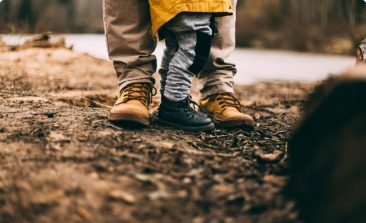Attachment with Baby
Attachment , soothing, and swaddling a baby
Bonding, arguably one of the most pleasurable parts of baby care, takes place during the sensitive time of the first few hours and days after birth when parents form a deep connection with their child. Physical closeness can foster an emotional connection.
For infants, attachment contributes to their emotional growth, which also affects their development in other areas such as physical growth. Another way to think of bonding is to “fall in love” with your baby. Children thrive when they have a parent or other adult in their life who loves them unconditionally.
Start bonding by rocking your baby and gently stroking them in different patterns. Both you and your partner can also take the opportunity to be “skin to skin” and hold your newborn against your own skin while feeding or rocking.
Babies, especially premature babies and those with medical conditions, may respond to infant massage. Certain types of massage can strengthen bonding and support infant growth and development. Many books and videos cover infant massage – ask your doctor for recommendations. Be careful though – babies aren’t as strong as adults, so massage your baby gently.
Babies usually love sounds like talking, babble, singing and cooing. Your baby will probably also enjoy listening to music. Baby rattles and musical mobiles are other good ways to stimulate your baby’s hearing. If your child is fussy, try singing, reciting poetry and nursery rhymes, or reading aloud while gently rocking or cradling your baby in a chair.
Some babies may be unusually sensitive to touch, light, or sound, and may startle and cry easily, sleep less than expected, or turn their faces away when someone is talking or singing to them. If this is the case with your baby, keep noise and light levels low to moderate.
Swaddling, which works well for some babies in the first few weeks, is another calming technique first-time parents should learn. Proper swaddling keeps a baby’s arms close to the body while allowing some movement of the legs. Swaddling not only keeps a baby warm, but seems to make most newborns feel safe and secure. Swaddling can also help limit the startle reflex that can wake a baby.
How to swaddle a baby:
Spread out the receiving blanket with one corner slightly folded over.
Lay the baby face up on the blanket, with the head over the folded corner.
Wrap the left corner over the body and tuck under the baby’s back, under the right arm.
Bring the bottom corner over the baby’s feet and pull it towards the head. Fold the fabric down when it gets close to the face. Be careful not to wrap too tightly around the hips. The hips and knees should be slightly bent and rotated outwards. Wrapping your baby too tightly can increase the chances of hip dysplasia.
Wrap the right corner around the baby and tuck it under the baby’s back on the left side, leaving only the neck and head exposed. To make sure your baby isn’t wrapped too tightly, make sure you can slip a hand between the blanket and your baby’s chest to allow for comfortable breathing. However, make sure that the blanket is not so loose that it could come loose.
Babies should not be swaddled after they are 2 months old. At this age, some babies can roll over while changing, increasing their risk of Sudden Infant Death Syndrome (SIDS).















































